ICE Mexican immigration banners have become key protest tools across the United States. These protest visuals reflect powerful messages on immigrant rights and national identity. As political tensions rise, more demonstrators adopt bold Mexican protest signs. These banners not only express solidarity but also capture cultural pride. They are used in marches, rallies, and public demonstrations. Activists rely on them to amplify their voices.
ICE-related policies have sparked controversy in immigrant communities. People use Mexican-themed protest visuals to counter narratives of fear and control. The red, white, and green imagery of the Mexican flag banners is hard to ignore. Protesters use large-scale signage to challenge immigration raids and family separations. Communities have adopted these materials as symbols of resilience and unity. Street artists and organizers often customize signs with bold fonts and creative graphics.
Visual Resistance Through Mexican Flag-Inspired Banners
Protesters use Mexican flag protest banners to draw attention to systemic issues. These visuals do more than decorate. They demand reform. Mexican heritage colors communicate identity and emotion. Green symbolizes hope, white stands for unity, and red reflects the blood of heroes. These elements make the banners both artistic and meaningful.
Hand-painted posters, silk-screened flags, and vinyl displays flood immigration rallies. Mexican pride posters display slogans such as “No Human Is Illegal” and “Familia Es Todo.” These signs often feature symbols like eagles, fists, and hearts wrapped in barbed wire. Protesters carry them during ICE facility protests and sanctuary city events. Many signs are bilingual to reach broader audiences.
Community groups organize workshops to create these materials. People gather to craft resistance banners that carry powerful cultural messages. These DIY events often turn into cultural festivals, complete with music and food. The use of Mexican-inspired protest art keeps the community connected. It also offers a therapeutic outlet for trauma and fear.
How ICE Mexican Immigration Banners Are Designed for Maximum Impact
Design plays a major role in the effectiveness of Mexican protest banners. Bold fonts, vibrant colors, and iconic visuals increase engagement. A banner reading “Abolish ICE” in dripping red lettering leaves a lasting impression. These visuals are designed to be shared online. Protestors post images on social media to extend their reach.
Artists design Mexican flag immigration signs with purpose. They balance emotional appeal with factual messaging. Some include statistics about deportation. Others quote immigrant families directly. Words like “libertad,” “dignidad,” and “resistencia” often appear. Combining Spanish and English ensures the message resonates across communities.
Poster creators often incorporate indigenous symbols, such as Aztec suns and traditional textiles. This links modern struggles to historical resistance. The goal is to express pride and protest simultaneously. These visual tactics push immigration issues to the national spotlight. The more distinctive the sign, the more likely it will be photographed and remembered.
The Role of Social Media in Spreading Immigration Banner Messages
Social platforms like Instagram, TikTok, and X (formerly Twitter) help amplify banner messages. Protesters photograph and post their signs instantly. Hashtags such as #AbolishICE, #NoBorders, and #ImmigrationRights increase visibility. This online momentum gives physical protests a digital afterlife.
Viral Mexican protest posters generate widespread awareness. Creators often design their signs with virality in mind. A sharp image with clear wording spreads faster. Protestors now upload templates online for others to print and use. Downloads of Mexican heritage protest signs have increased dramatically in recent years.
Online galleries and activist blogs showcase creative protest materials. These platforms offer tips on making durable banners. Artists share design inspiration and printable artwork. Grassroots movements benefit from these free resources. They empower even small groups to make bold public statements.
Digital storytelling through banners has become essential. Protesters now use short videos to explain the meaning behind their signs. This adds emotional depth to the images. People engage more with content that has a human story behind it. Mexican immigrant advocacy groups use this strategy to build loyalty and drive support.
Community Organizing Around Mexican Banners Against ICE
Community centers and activist groups regularly host banner-making events. These spaces offer tools and guidance for creating protest materials. Events often begin with educational discussions about immigration law and ICE actions. Participants leave with signs and a deeper sense of purpose.
Religious groups, schools, and cultural collectives support these initiatives. Faith-based banners often feature peaceful messages and symbols of love. Students create school-safe protest placards for walkouts and rallies. Cultural organizations use art therapy workshops to help immigrant families heal while taking action.
Neighborhood marches showcase hundreds of Mexican solidarity signs. These signs often include family portraits, names of detained relatives, or immigration stories. Personal touches add power to every visual. Seeing a neighbor’s pain and pride side-by-side builds unity.
Immigration advocacy groups also fund large-scale professional banners. These include durable materials for long-term use. Fabric banners printed with traditional Mexican motifs are popular in recurring protests. They reflect cultural authenticity and emotional resilience. Protest visuals have grown more polished and strategic without losing heart.
The Future of Immigration Activism Through Mexican Protest Art
Mexican banner art continues evolving as immigration policies shift. New design trends reflect growing coalitions between Latinx, Black, and Indigenous communities. Intersectional visuals show solidarity across movements. Artists create multi-layered banners that fight for justice on multiple fronts.
Immigrant youth now lead many visual campaigns. They design digital-first posters that thrive both in-person and online. Their tools include mobile design apps and affordable print services. High schools and universities hold competitions for best activist artwork. Winning pieces are displayed at rallies and across campuses.
Sustainability is now part of banner creation. Activists use recycled fabrics, biodegradable paint, and upcycled materials. Some create modular banners that can be reworded for different protests. This ensures long-term use and lowers environmental impact.
As technology and politics evolve, so will the protest visuals. But the heart remains the same. Mexican flag protest banners speak truth to power. They symbolize love for one’s roots and hope for one’s future. These artistic expressions continue to energize immigrant rights movements nationwide.
Please make sure you protest peacefully. As we have seen the Los Angeles anti immigration rallies turn destructive and violent.





